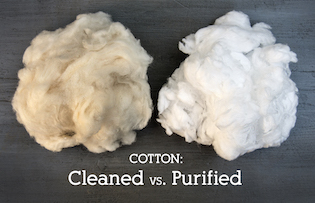When comparing purified cotton to unpurified cotton, the obvious difference is in one simple “un.” However, just saying that a fiber is purified or unpurified leaves out a lot of important details. Today we’ll discuss the differences between the two, and why those differences are very important.
First, what is pharmacopeia?
Pharmacopoeia, pharmacopeia, or pharmacopoeia (literally, “drug-making”), in its modern technical sense, is a book containing directions for the identification of compound medicines, and published by the authority of a government or a medical or pharmaceutical society. Descriptions of preparations are called monographs. In a broader sense, it is a reference work for pharmaceutical drug specifications.
Why are there pharmacopeia specifications for purified cotton?
There are pharmacopeia specifications for “purified cotton” around the world. In the United States there is U.S. Pharmacopeia (USP), in Europe there is EP, and in the Far East there is JP; all exist to ensure the purity of cotton used in medical products meets certain specifications. Although the limits may vary a little between the specifications for each of the pharmacopeia regions, they all measure the same properties via the same test methods.
Cotton as it comes from the fields is coated with waxes to protect the fiber from the rain. It is therefore non-absorbent. It also contains minerals, herbicides, and pesticides used during growing and could contain pest waste residue as well. The Barnhardt purification process removes all of these contaminants, leaving absorbent, white cotton fibers that are pure cellulose. These fibers pass all pharmacopeia specifications, making them suitable for medical grade products such as gauze, sponges, and tampons. Also, they are not included in the OSHA cotton dust standard requirements for worker safety that are in place in the U.S. These requirements state that employers who process unpurified (mechanically cleaned) cotton must annually monitor and record employee cardio-pulmonary functions and maintain certain levels of dust in the working environment. This is to prevent employees from contracting byssinosis (brown lung), a disease associated with long-term breathing of cotton dust. Purified (wet processed) cotton is exempt from these requirements.
What is the pharmacopeia definition of purified cotton?
Purified cotton is the hair of the seed of cultivated varieties of Gossypium hirsutum Linné, or of other species of Gossypium (Fam.Malvaceae), and also freed from adhering impurities, deprived of fatty matter, and bleached.
What are the pharmacopeia specifications?
The following are the areas that are measured for all pharmacopeia specification (USP, EP, JP). Please note that the upper limits of their presence vary between them.
Alkalinity or Acidity:
The pH of the hot water soluble extract of the fiber must be within a certain range centered around neutral (pH of 7).
Residue on Ignition:
The fiber is burned to completely consume the carbon in the fiber, leaving only the inorganic materials (minerals) behind (which are measured). These must be below the specification value.
Water-Soluble Substances:
The amount of impurities removed by hot water extract must be less than the prescribed upper limit.
Fatty Matter Extractables:
An organic solvent is used to extract materials that are not water-soluble. The amount of fatty soluble impurities removed must be below the specified level.
Absorbency:
There are two parts to this. The first is sink time. A standard size sample of fibers is placed in a container that is dropped into water, and the time it takes to sink is measured (for USP, the fiber must sink in less than 10 seconds). The second is capacity. The same sample that was used to sink is allowed to stay in the water 10 seconds and is removed and drained a prescribed number of seconds, and then the water absorbed is measured. The requirement for USP is the fiber must absorb more than 24 times its weight in water.
What are the benefits of pharmacopeia purified vs. unpurified cotton?
1. Unpurified cotton may not meet the requirements for ash, water soluble, and/or fatty matter. Since cotton is a natural fiber and grown in different environments and locations, the amounts of impurities present is different for all fibers. As noted above, Barnhardt purified cotton does meet the requirements.
2. Unpurified cotton is non-absorbent. Purified cotton is absorbent and will absorb up to 26 times its own weight.
3. Unpurified cotton has an off-white or grayish color. Purified cotton is bright white, which is consumer-preferred.
4. Unpurified cotton may contain residual pesticides, herbicides, or genetically modified genes. Purified cotton is free from all of these. Even if grown from GMO seeds, the purification process removes all genetically modified proteins.
5. Using unpurified in the U.S. to produce nonwoven fabrics requires the manufacturing companies to meet the OSHA cotton dust standards. Purified cotton is exempt because of its safety profile.
To learn more about purified cotton, visit Barnhardt’s specific Purified Cotton™ website.
